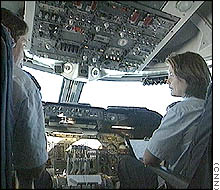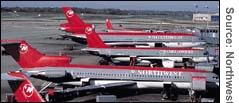|
Skies safe from layoffs
|
 |
August 24, 2001: 2:45 p.m. ET
Few layoffs on the runway despite losses at nation's major airlines
By Staff Writer Chris Isidore
|
NEW YORK (CNNfn) - The best place to find protection from layoffs in the face of declining sales and mounting losses is apparently at 30,000 feet.
While the nation's airline industry prepares to post a cumulative $2 billion in losses this year, the total number of furloughs within the industry is well less than 1 percent of the overall work force. Very few pilots, flight attendants or mechanics find themselves out of job, despite the sharp downturn in demand for air travel by the carriers' core business travelers.
| |

|
|
Despite mounting losses at the nation's major airlines, layoffs remain rare for pilots and other operating employees at the carriers. | |
While United Airlines, a unit of No. 2 airline company UAL Corp. (UAL: up $1.07 to $34.19, Research, Estimates), and No. 3 U.S. airline Delta Air Lines (DAL: up $1.91 to $40.92, Research, Estimates) have imposed hiring freezes, American Airlines, a unit of the world's largest airline holding company AMR Corp. (AMR: up $1.17 to $33.89, Research, Estimates), continues to hire pilots even as it plans to trim its fleet.
"We've got pilots retiring. They need to be replaced," said Mark Slitt, spokesman for American. "The reduction in capacity is not dramatic enough to require large cuts."
One airline executive, who spoke on the condition he not be identified, said that furloughs or layoffs are not on the horizon any time soon, despite the continued losses that show no sign of letting up.
"You never say never on furloughs. As industry, everyone is watching very closely what occurs. But furloughs is not something we've had a lot of discussions about," said the executive.
Kit Darby, president of Air Inc., an airline career information service, said that of 94,574 pilots at U.S. carriers, only 818 are on furlough, and many of those are on the ground due to unique circumstances, such as the Federal Aviation Administration's recent demand that air cargo carrier Emery Worldwide ground its planes due to alleged safety violations, or the significant cut in capacity at regional airline Comair, a unit of Delta, which slashed its system during a three-month pilots strike earlier this year.
"This is a high fixed-cost industry, and you can't support fixed costs if you're not operating," said Darby. "You can't cut your ways to profits."

|
|
|
Northwest is cutting 1,500 staff positions, but a growth in fleet size means no layoffs of pilots, flight attendants or mechanics. | |
Upstart carrier Midway Airlines was forced to file for bankruptcy protection, leading it to cut its 700 of its staff, while Northwest Airlines (NWAC: up $0.82 to $21.62, Research, Estimates) and America West Airlines (AWA: down $0.07 to $9.48, Research, Estimates) have announced programs to trim work forces through cuts in administrative and support staff. Despite a cut of 1,500 positions at Northwest and a 10 percent reduction in administrative and clerical staff at America West, no pilots, mechanics or flight attendants have been laid off at either carrier. So the industry has mostly been spared the pain of the layoffs in sectors such as telecom and technology.
"You have to remember the airlines didn't have the huge amount of over-investment that prompted growth and hiring that the telecom and technology sectors," said Jim Higgins, analyst with Credit Suisse First Boston. "My suspicion is you'll see gradual enough reduction in capacity, [but] that you're not going to see huge layoffs."
Airlines are also one of the most heavily unionized sectors of the economy, and some of the union contracts have limits on layoffs that would only allow modest cuts of the lowest-paid pilots or other operating staff. And despite a number of recent labor agreements, a number of carriers are facing continued contract talks with pilots, mechanics and flight attendants.
"Especially if you're in contract negotiations, you help yourself a lot in terms of good will by avoiding layoffs," said Higgins. "I think the industry has been pretty rational."
The operating employees generally have a high skill level that would make replacing them expensive when demand picked up again.
"There's been a serious shortage of mechanics and the airlines have been creative trying to attract people to those jobs," said Darby. "Flight attendants don't have same profile as mechanics or pilots, but again the airlines have had a lot of trouble attracting them."
| |

|
|
United Airlines is speeding up retirement of some older jets, like this 727, but it has not needed to furlough any staff. | |
The trimming of fleet taking place at American and the other major carriers is relatively modest, equal to about 1 percent of capacity.
Airlines are unwilling to make deeper cuts in fleets because order for jets have to be placed years in advance, and the newer jets are far more fuel efficient than older models.
While the carriers are speeding up the retirement of older fuel guzzlers such as the Boeing 727 narrow-body jets, or the MD-11 or L-1011 jumbo jets, they don't want to make those cuts too deeply, in case demand comes back sooner than they could get new aircraft back in service.
"You want to keep assets in place for when you have a recovery," said Ray Neidl, analyst with ABN Amro. "By the time you're in a recession, you have to be making plans for the recovery. It's not like a factory where you can just lock and then reopen the door. There's a lag effect."
The mounting losses at the major carriers has also been tied to a sharp decline for top-paying business travelers. That has prompted fare wars that have kept planes still relatively filled with the lower-paying leisure travelers, which also limits the ability of airlines to cut staff.
"You still need the employees to move the masses, even if the masses aren't paying as much as their tickets."
Click here for a look at airline stocks
Because of the rapid growth in air travel in the mid 1970s, retirements are expected to climb at airlines in the coming years. According to statistics from Air Inc., about 1,300 pilot retirements are expected this year, and that is expected to climb steadily through 2007 to 2,342. 
|
|
|
|
|
 |

|

